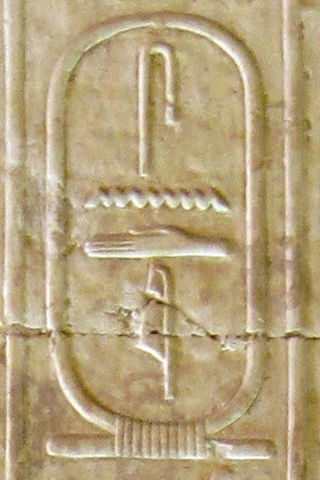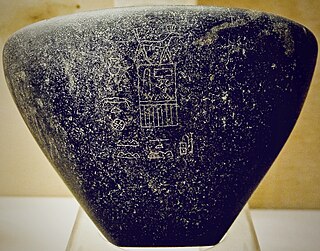
The Second Dynasty of ancient Egypt is the latter of the two dynasties of the Egyptian Archaic Period, when the seat of government was centred at Thinis. It is most known for its last ruler, Khasekhemwy, but is otherwise one of the most obscure periods in Egyptian history.

Nynetjer is the Horus name of the third pharaoh of the Second Dynasty of Egypt. The length of his reign is unknown. The Turin Canon suggests an improbable reign of 96 years and Egyptian historian Manetho suggested that Nynetjer's reign lasted 47 years. Egyptologists question both statements as misinterpretations or exaggerations. They generally credit Nynetjer with a reign of either 43 years or 45 years. Their estimation is based on the reconstructions of the well known Palermo Stone inscription reporting the years 7–21, the Cairo Stone inscription reporting the years 36–44. According to different authors, Nynetjer ruled Egypt from c. 2850 BC to 2760 BC or later from c. 2760 BC to 2715 BC.

Weneg, also known as Weneg-Nebty, is the throne name of an early Egyptian king, who ruled during the Second Dynasty. Although his chronological position is clear to Egyptologists, it is unclear for how long King Weneg ruled. It is also unclear as to which of the archaeologically identified Horus-kings corresponds to Weneg.

Senedj was an early Egyptian king (pharaoh), who may have ruled during the 2nd Dynasty. His historical standing remains uncertain. His name is included in the kinglists of the Ramesside era, although it is written in different ways: While the Abydos King List imitates the archaic form, the Royal Canon of Turin and the Saqqara King List form the name with the hieroglyphic sign of a plucked goose.

Seth-Peribsen is the serekh name of an early Egyptian monarch (pharaoh), who ruled during the Second Dynasty of Egypt. His chronological position within this dynasty is unknown and it is disputed who ruled both before and after him. The duration of his reign is also unknown.

Sekhemib-Perenma'at, is the Horus name of an early Egyptian king who ruled during the 2nd Dynasty. Similar to his predecessor, successor or co-ruler Seth-Peribsen, Sekhemib is contemporarily well attested in archaeological records, but he does not appear in any posthumous document. The exact length of his reign is unknown and his burial site has yet to be found.
Neferkara I is the cartouche name of a king (pharaoh) who is said to have ruled during the 2nd Dynasty of Ancient Egypt. The exact length of his reign is unknown since the Turin canon lacks the years of rulership and the ancient Egyptian priest Manetho suggests that Neferkara's reign lasted 25 years. Egyptologists evaluate his statement as misinterpretation or exaggeration.

Nimaathap was an ancient Egyptian queen consort at the transition time from 2nd Dynasty to 3rd Dynasty. Nimaathap may have acted as regent for her son Djoser.

Neithhotep or Neith-hotep was an ancient Egyptian queen consort who lived and ruled during the early First Dynasty. She was once thought to be a male ruler: her outstandingly large mastaba and the royal serekh surrounding her name on several seal impressions previously led Egyptologists and historians to the erroneous belief that she might have been an unknown king. As the understanding of early Egyptian writings developed, scholars learned that Neithhotep was in fact a woman of extraordinary rank. She was subsequently considered to be the wife of unified Egypt's first pharaoh, Narmer, and the mother of Hor-Aha.
Meritites I was an ancient Egyptian queen of the 4th Dynasty. Her name means "Beloved of her Father". Several of her titles are known from a stela found at Giza. She was buried in the middle Queen’s Pyramid in Giza.
Khenthap was allegedly a queen of Ancient Egypt. She is said to have lived during the 1st Dynasty. Her historical figure is very obscure, since there are no contemporary sources for her name. She appears only once in a much later inscription.
Betrest was a queen of Ancient Egypt. She lived during the First Dynasty.

Nakhtneith was a Queen consort of ancient Egypt. She lived during the 1st Dynasty. Her name means "strong is Neith".
Hekenuhedjet was an ancient Egyptian queen consort of the 4th Dynasty, a wife of pharaoh Khafre. She is depicted in the tomb of her son, the vizier Sekhemkare.
Hudjefa is the pseudonym for a 2nd Dynasty pharaoh as reported on the Turin canon, a list of kings written during the reign of Ramses II. Hudjefa is now understood to mean that the name of the king was already missing from the document from which the Turin canon was copied. The length of the reign associated to Hudjefa on the canon is 11 years. Because of the position of Hudjefa on the Turin list, he is sometimes identified with a king Sesochris reported in the Aegyptiaca, a history of Egypt written by the Egyptian priest Manetho in the 3rd century BC. Manetho credits this pharaoh with 48 years of reign. Egyptologists have attempted to relate Hudjefa with archaeologically attested kings of the period, in particular Seth-Peribsen.

Sneferka was an early Egyptian king who may have ruled at the end of the 1st Dynasty. The exact length of his reign is unknown, but thought to have been very short and his chronological position is unclear.

Horus Bird, also known as Horus-Ba, may have been a pharaoh who may have had a very short reign between the First and Second Dynasty of Egypt. Horus-Bird's burial site is unknown.
Akhty was an ancient Egyptian deity. He was seldom mentioned.

Neferukayet was an ancient Egyptian princess and queen of the Eleventh Dynasty. Her name is only known from her steward Rediukhnum's stela, which was found in Dendera. She is possibly identical with the mother of Intef III, whose name was Neferu. Neferukayet also bore the titles "king's daughter" (z3.t-nỉsw.t), "king's beloved wife" (ḥm.t-nỉsw.t mrỉỉ.t=f) and "royal ornament" (ẖkr.t-nỉsw.t), based on this, she was likely the daughter of Intef I and the wife of Intef II. Furthermore, in the tomb of king Intef III was found a relief fragment naming a woman called Neferukau. Silke Roth argued that Neferukau is just a different writing for the name Neferukayet. Neferu would be just a short version of the name Neferukau/Neferukayet.













